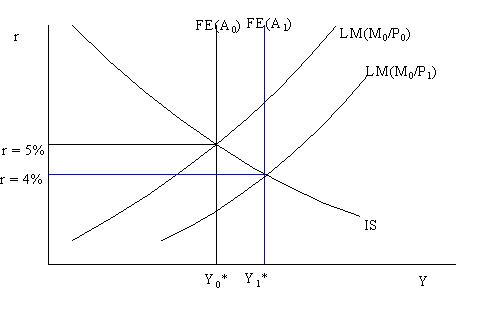
Reading: AB, chapter 10

Consider the economy initially in general equilibrium with r* = 5% and full employment output Y*. Recall, in general equilibrium the labor market is in equilibrium, the goods market is in equilibrium (aggregate demand = aggregate supply) and the money market is in equilibrium. The initial price level is given by P0. Now suppose that productivity temporarily increases from A0 to A1. This could be due to, for example, a temporary decrease in the price of oil. Recall, the textbook defines a temporary change as one that does not affect expectation variables and that a permanent change does affect expectation variables. The increase in productivity shifts up the production function, shifts out the demand for labor and leads to higher levels of employment, output and the real wage (assuming the price level is fixed at P0 the higher real wage is due to a higher nominal wage) . As a result, the FE (full employment output) line shifts to the right and the new potential supply of goods is now Y1*. At r = 5%, the level of aggregate demand (determined by the intersection between IS and LM) is less than the aggregate supply of goods, Y*. Firms will see their inventory of goods pile up and they will respond by decreasing prices. As overall prices (and nominal wages) fall, the LM curve will shift down and to the right and the real interest rate will fall. As r falls, interest sensitive spending (consumption and investment) rises as we move along the IS curve toward the new general equilibrium at r = 4%. At the new equilibrium, output (Y), employment (N), the real wage (W/P), consumption (C), investment (I) and saving (S) are higher and the real interest rate (r) and the general price level (P) are lower.
[Previous Slide] [Contents for Lecture 9] [Slides from Lecture] [301 Homepage]
Last updated on July 22, 1996 by Eric Zivot.